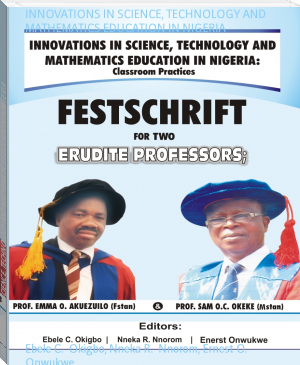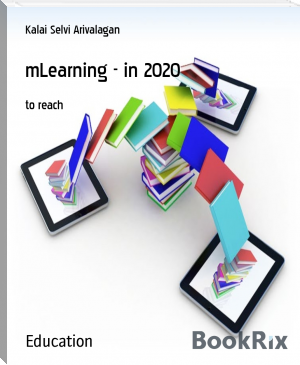INNOVATIONS IN SCIENCE, TECHNOLOGY AND MATHEMATICS EDUCATION IN NIGERIA, Ebele C. Okigbo, Nneka R. Nnorom, Ernest O. Onwukwe [best reads .TXT] 📗

- Author: Ebele C. Okigbo, Nneka R. Nnorom, Ernest O. Onwukwe
Book online «INNOVATIONS IN SCIENCE, TECHNOLOGY AND MATHEMATICS EDUCATION IN NIGERIA, Ebele C. Okigbo, Nneka R. Nnorom, Ernest O. Onwukwe [best reads .TXT] 📗». Author Ebele C. Okigbo, Nneka R. Nnorom, Ernest O. Onwukwe
Recommendation
The following recommendations were made that;
In educational system, the decision-makers and implementers should have enough knowledge on whether the investments for the integration of ICT in curricular will be directed according to teachers’ level of knowledge, how are they using it in teachin- learning process, as well as their attitudes. As it is, educating teachers who will use this technology in the classroom to integrate them into the curricula will become a more important issue.
Secondary schools should be well equipped with adequately functional and well-furnished computer laboratories/cyber cafes for teachers and student use.
Reference
Achukwu, B. C. & Nnajiofor, F. N. (2012).Assessing preparedness of academic staff in using E-Learning for instructional delivery through their ICT competence. International Journal of Educational Research and Development, 5(1); 263-269.
Aguba, C. R. (2013). Strategies for effective management of Information and Communication Technology (ICT) in secondary schools: Implication for National Transformation. Unizik Orient Journal of Education, 7(1); 142-146.
Akudolu, L-R.(2002). Restructuring Nigerian secondary education system through Information and Communications Technology (ICT) driven curriculum. Journal of the world council for curriculum and instruction, Nigeria chapter, 3 (1); 8-17.
Akudolu, L-R & Olibie, E. (2007).Seeking appropriate ICT teaching approach for developing teacher-ICT competencies. Views from European Union. Oriented Journal of Education, 3(1); 33-38.
Alaba, O. A. (2010). Gender, academic qualification subject discipline differentials of Nigerian teachers’ ICT literacy .Journal of Education Technology, 8(1) . Retrieved from www.goggle.com
Amrit, P. K. (2011). Pre-service Science Teachers’ attitudes towards the use of selected ICT tools in teaching: An exploratory study. Retrieved from www.goggle.com.
Bajah, S. T. (2006). Teaching Science Creativity. The contributions of science teachers association of Nigeria. Retrieved on 4th March 2010 from http://www.nap.edu/open book/0309051479/html//copyright/2006.
Egboka, P. N. (2012). The status of Information and Communication Technology (ICT) in empowering policy implementation in university in South East Zone of Nigeria. International Journal of Educational Research and Development, 5(1); 263-269.
Egboka, P. N. & Olibie, E. I. (2010).Extent of provision and integration of ICT for implementing in Nigeria. International Journal of Education Research and Technology, 1(1); 64-69
Erdogan, T. (2010). Attitudes and knowledge level of teachers in ICT use: The case of Turkish teachers. International Journal of Human Science,7(2). Retrieved from http://www.balikesir.edu.com.
Federal Republic of Nigeria (2008) National Policy on education. Revised edition. Abuja: Nigerian Educational Research and Development Council Press.
Federal Republic of Nigeria. (2004). National Policy on education (4thed.). Lagos: Nigerian Educational Research and Development.
Gell, M, & Cochrane, P. (1996).Learning and Education in an information society. In Dulton, W.H. Led, information and communication technologies visions and realities 249-263.New York; Oxford University Press.
Kibirige, I. (2011). In service science teachers’ attitude towards information and communication technology. South African Journal of Higher Education, 25(8); 1513-1525. Retrieved from http://www.goggle.com.html
National Research Council (1996).The national science education standards. Washington, DC: National Academy Press.
Ndidde, A. N. (2011). Gender disparity in ICT use. Retrieved from www.observatoiretic.org
Okafor, I. C. (2009).ICT as a basis for National Development. Enugu: Amazing Publisher.
Obidike, N. D., Anyikwa, N.E. & Enemuo, J.O. (2010). Teachers’ Awareness of the existence and the use of Technology to promote children’s literacy instruction in Awka local government Education zone, Anambra state. Africa Journal of Teacher Education, 1(1). Retrieved November 2011 from http://www.spreadcorp.org/ajote/ index
Onasanya, S.A., Shehu, R.A., Oduwaiye, R.O., & Shehu, L. A. (2010).Higher institutions lecturers’ attitude towards integration and Research in Nigeria. Journal of Information Technology, 2, 1-10
Onasanya, S. A., Shehu, R. A., Ogunlade, O. O., & Adefuye, A. L.(2011). Teachers awareness and extent of utilization of Information and Communication technology for effective science and health education in Nigeria. Singapore Journal of Scientific Research, 1,49-58.
Onohwakpor, E. J., & Rhima, J. E. (2008).A survey of Teachers’ level of computer literacy and awareness of information and communication Technology for Application of Science, Technology and Mathematics Education. Journal of Educational Technology, 12(2). Retrieved from www.google.com.
Osisioma, I. (2012). Re-Imagining the Nigerian science and technology education: Equipping the Nigerian child with skills and competencies to succeed in the competitive global community. International Journal of Educational Research and Development, 4(2); 13-21.
Ukeje, B. O. (2002). The Future of teacher education in Nigeria in teacher education in Nigeria: past, present and future. Proceedings of the first Teachers, Summit. Kaduna: NTI.
ASSESSING THE DIGITAL TECHNOLOGICAL SKILLS OF SCIENCE EDUCATORS TEACHING SCIENCE TO UNDERGRADUATES IN IMO STATE
Dr. Helen N. Ibe
&
Chimmuanya Ezere
Abstract
This study assessed the digital technological skills of undergraduate science educators in science teaching. The sample consists of 205 final year students of science education and 13 science educators in Owerri, Imo state. The Survey research design was adopted for this study. Two objectives guided the study. Two corresponding research questions were posed. The research questions were answered with Means and Standard Deviation. The Instrument used for data collection was a Rating Scale titled: Digital Technological Skills of Science Educators Rating Scale” (DTSOSERS). Coefficient of internal consistency was established at 0.71 using Cronbach alpha reliability. Findings show that undergraduate science educators require digital technological skills in science teaching. The study also revealed that undergraduate science educators do not possess as well as use the needed digital technological skills in their science classrooms. It was recommended that Awareness be made more often on the need for undergraduate science educators to engage in personal improvement of their digital technological skills; Undergraduate science educators be exposed to occasional technological professional development with emphasis on development of their digital technological skills; and Faculties of education should provide undergraduate science educators with digital gadgets such as laptops, tablets, overhead projectors, statistical software etc. for science teaching in order to keep abreast of useful technological skills for teaching.
Keywords: Assessing, Digital Technological Skills, Science Educators
Introduction
The digital world is increasingly penetrating the science education and skills domain, with technology gradually being used to deliver knowledge and skills in new and innovative ways. Eady and Lockyer (2013) stated that digital technology has pervaded every aspect of our civilization, it has set forth a revolution not only in how we store and transmit recorded knowledge, historical records, and a host of other kinds of communication but also in how we seek and gain access to these materials.
Given the increased use of fast changing digital technologies in various institutions and workplaces, new skills and needs have emerged. The use of these technologies has contributed to transforming science learning into a lifelong process (Vries, 2010). Indeed, people now have to continue to develop and refresh their skills and knowledge in order to keep abreast with the constant innovations and new developments in the digital world. For some members of society, such as the younger generation who are otherwise referred to as ‘digital natives’, using technology is natural, but this is not necessarily the case for all. As technologies in general and media in particular have broken into homes, it is necessary for students and educators in all disciplines to become more digitally competent (Lafee, 2013).
From the wheel to the printing press to the mobile phone, technology has shaped human history and will continue to do so. Today, computers and the digital revolution are spreading across the globe, creating connections we have never before imagined and possibilities only before dreamed of in science fiction (Armstrong & Earle, 2012). Technology, in one form or another, has always been part of the teaching and learning environment. It is part of the teacher’s professional toolbox. In other words, it is among the resources that teachers use to help facilitate student learning.
Technology has changed dramatically over recent decades. The increasing variety and accessibility of technology has expanded the toolbox and the opportunities teachers have to use technology. Computer devices are more powerful and come in different forms, from those that sit on our desks to those that sit in the palm of our hands. The internet connects those devices and connects lecturers and students to each other in the classroom, through the school and around the world. Technology in schools in some developed countries has become mobile and digital, with laptop computers, tablet devices and smart phones now part of the teaching and learning context (Williams, 2012).
Digital technological skills are technical skills required to use digital technologies. These skills include finding information, prioritising information and assessing the quality and reliability of information etc. In a world which is basically hinged on technological innovations, the undergraduates in tertiary institutions are not the only ones who have the responsibility of improving their technological skills (Cloete, 2017). While artificial intelligence, exponential increases in computing power and expanding mobile networks hold potential to make our lives easier and safer, they also threaten to leave those at the bottom even farther behind if not evenly distributed (Dawson, 2012). The lecturers have a huge gap to fill when it comes to the development of digital technological skills. The science educator is a determining factor in the transmission of technological competence in science classrooms and must be updated constantly; the student becomes the center of the teaching-learning process, and must receive the full support of the teacher. They have to keep abreast with the latest tech inventions which enhance effective teaching and learning in science classrooms.
In the views of Fakhteh, Zahra, and Fariba (2012), the world and the changes coming in the future require education to prepare children for a world of rapid change in technology, increasing interconnectedness, and new forms employment. No longer is the focus on mastering content knowledge via memorization sufficient in the age of Google.
According to the US Department of Education (2017), science educators have listed some barriers to digital tech innovations as:
Lack of skills development- since digital technology skills are not part of science educators’ continuing professional development, improving their digital tech skills is not always seen as mandatory. Most times, science educators are not systematically well prepared to deal with the increased use of technologies.
Systemic institutional barriers: Some institutions remain closed to digital learning, as do accreditation bodies with education accessed through digital technologies.
Poor interaction between groups: Not enough is being done by education technology providers to explore the pedagogy behind the use of the technology. In turn, the use of technology in science education is not fed back to the educators.
The benefits of using digital technology to both science educators and undergraduates in science education according to Budwhar, (2017) include: a) acceleration and exchange of information- learners will be able to acquire new information in a shorter time. The science educators will be able to classify their beliefs and participate in discussions in online and offline mode with colleagues from different areas around the world; b) enhancement of learning and interaction between undergraduates, educators and programs - Communication practices, especially technology-based asynchronous communication, cognitive or social interaction between lecturers and students improve and extends the knowledge of participants; c.) development and Promotion of Information Literacy Skill- Information literacy skill entails collecting, processing and dissemination of information as text, graphs and exchange of these information on teaching and learning environment strengthens the students’ and lecturers’ ability in collecting and processing information.
This study is anchored on Cognitive load theory, developed by John Sweller (1988). The theory states that learning must be designed to reduce the load on students’ working memory in order for them to be able to construct schema. John Sweller proposed that educators should arm themselves with digital skills or resources which would enable them manipulate digital technologies for proper transmission of knowledge in the classrooms. According to Him, effective use of these digital skills exclude information and activities that are not directly related to schema construction; focus on information and activities that directly relate to schema construction; and clearly identify the complexity of learning materials and experience of learner.
These principles guide science educators in evaluating the digital skills that they might want to use with their students.
The interests of most undergraduates are attracted in the class by incorporating digital facilities in their learning. Although much emphasis





Comments (0)